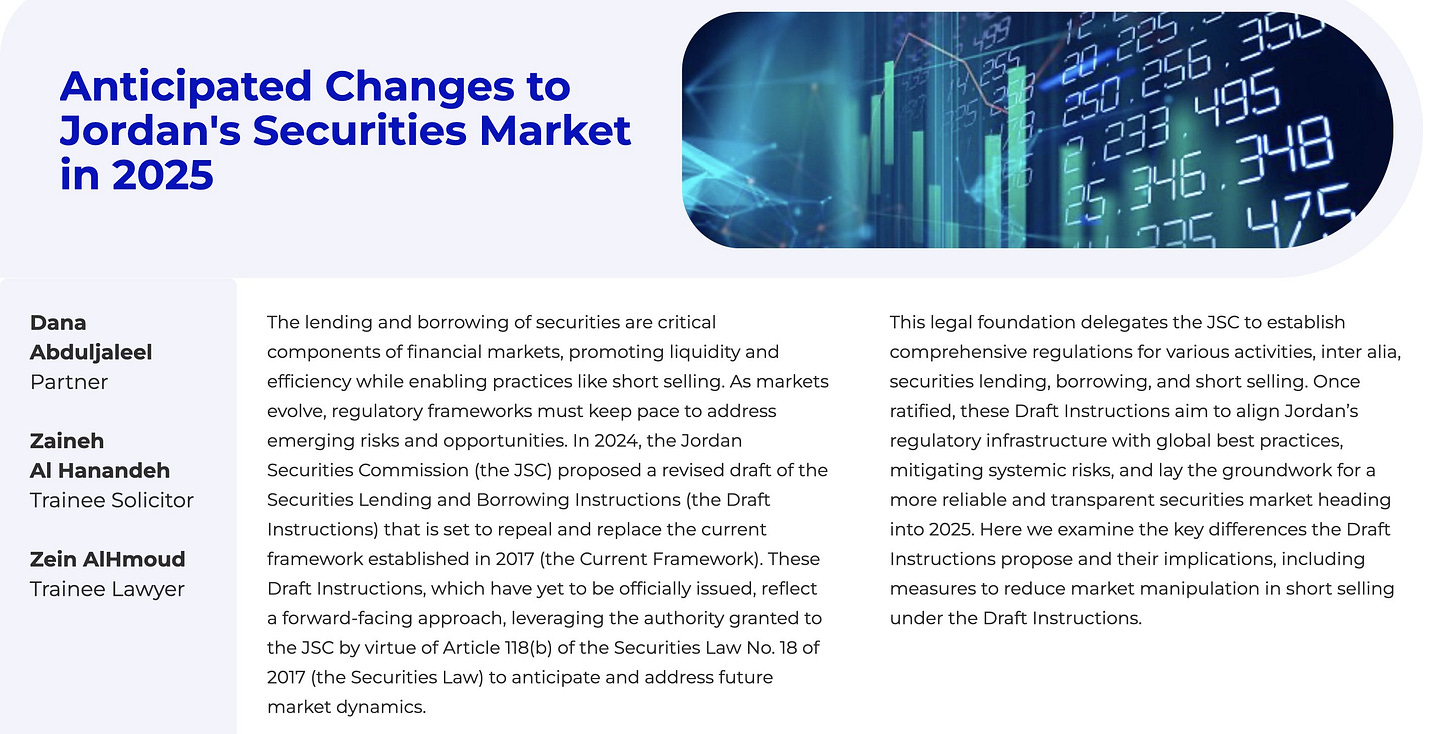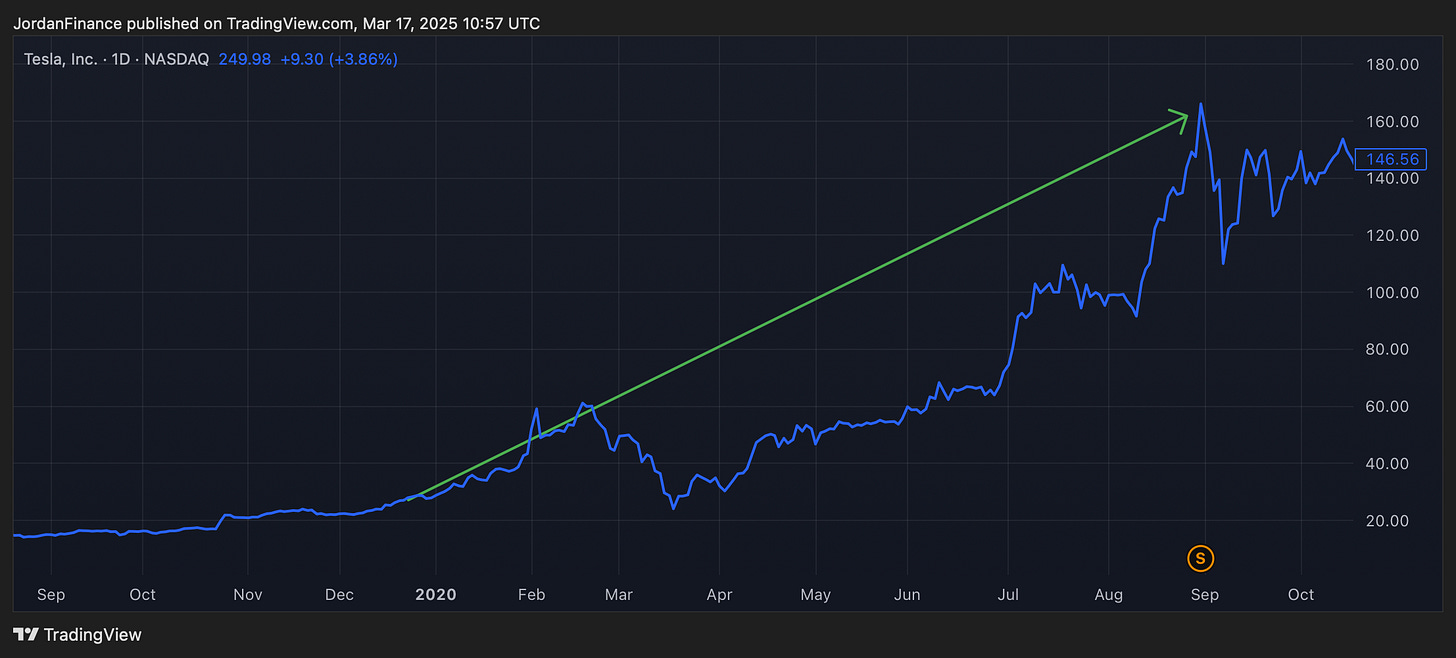The winner of the Ig Nobel Prize of Economics1 in 1994 was a Chilean 🇨🇱 futures trader who in 1 day of bad trading wiped out 0.5% of Chile’s GDP.
This is due to a “futures” contract relating to commodities, one of many financial derivative instruments available for traders and investors. In stocks, you have options and short selling.
The Amman Stock Exchange (ASE) and the Jordan Securities Commission (JSC) are looking to introduce at least 1 new instrument: short selling.
So what is it?
Quick example on short selling:
Investor A owns shares of publicly traded company called SHARIKA. The share price is 1 JOD as of today’s market close.
Investor B has a hunch that the price of the company will fall (maybe a distant relative who works there was complaining about how bad things are inside).
Investor B borrows the shares from Investor A. As borrower, Investor B sells the shares in the market at 1.05 JODs/share. 2 months later, the price of the share is 0.8 JODs. Investor B buys the shares back from the market and returns them to the lender and original owner Investor A.Investor B profited from the fall of the price (by selling high first and buying low afterwards thanks to the process of borrowing the shares; a buy/sell process but in reverse order).
This is short selling in its most basic form: it is a borrowing/lending contract of shares in the market. And every lending contract comes with interest and a fixed duration. What is very important is the legal framework and guarantee to protect investor A and make sure that their shares will be returned.
The Draft Law’s Shortcomings

Here is the full text of the draft: Link
A few comments on the draft (I know I’m late at submitting them, but better late than never):
Article 9 (d) item 3:
ان يكون للمقرض في حسابه في السجل المركزي عدداً كافياً من الاوراق المالية لتنفيذ العقد وقت ادخال الطلب وأن تكون تلك الأوراق المالية غير مثقلة بأي حجوزات او رهونات او أي قيود أخرى تمنع التصرف.
The joke circulating in Jordan is that everyone is in debt, and in this case, everyone’s shares are sequestered by other lenders and therefore cannot be acted upon. This leaves the problem with a very small number of shareholders who can lend their shares. The biggest lender in this case will be none other than the Social Security Investment Fund (SSIF). Now one of the benefits for the SSIF to lend its massive portfolio is that it can gain an interest when it does so. And in the short to medium term, the SSIF doesn’t care much for price volatility as it thinks in long term growth of its assets. As the SSIF represents the retirement savings of most working Jordanians, allowing the SSIF to lend out shares can be seen as worrisome.Article 22:
يشترط أن يكون سعر ادخال أمر البيع المكشوف الى نظام التداول في السوق المالي محدداً فقط وان يكون أعلى من آخر سعر للورقة المالية.
It is not clear when the borrower of the share can sell. What do they mean the last price? Last price when the lending contract was made? Or market close (of which day)? If the latter and day of short selling, this can be problematic in terms of guarantee (point 4).Article 14 (a) & (b):
أ. يجب على وكيل الاقتراض متابعة أي تغييرات تطرأ على عدد الاوراق المالية المقترضة نتيجة لزيادة أو تخفيض رأسمال مصدر الورقة المالية المقترضة، واحتساب الاستحقاقات النقدية المرتبطة بالأوراق المالية المقترضة والتي تشمل قيمة الفائدة والارباح النقدية الموزعة من قبل المصدر او قيمة الرديات الناشئة عن تخفيض رأس المال أو قيمة حقوق الاكتتاب الناشئة عن زيادة رأس المال عن طريق الاكتتاب الخاص.
When dividends are paid out during a borrowing period where the borrower did not yet sell, who will get the dividends? The borrower or the lender? And what about dividend pay outs after short selling and before the contract ends (since the sold shares will be owned by a 3rd investor)?Article 8 (b):
مبلغ ضمان عقد الاقتراض بقيمة لا تقل عن (100%) من قيمة الاوراق المالية المقترضةHere starts the fun part. So a borrower must have the guaranteed amount of money, valued at the exact amount of the borrowed share, throughout the entire contract. And the borrower’s broker must make sure it stays over >100% at all times by monitoring the stock price. If the value of the guarantee goes below 100% (when the share price goes up, basically), the guarantee ‘pot’ needs to be refilled, or the contract ends (stop loss?). In the event the broker is worried the borrower won’t be able to fulfil the deal and that the shares are going up too fast, the broker could protect themselves (it’s called hedging) and buy the exact amount of shares just in case (as it will be cheaper in the long run). Although we are not dealing with option trading, this is somewhat close to delta hedging2 (see example in footnote). If the borrower has to sell above the market price3, then the price will always go up and therefore they will always need more than 100% (unless the broker and borrower have a leverage understanding).
My Short Take
I’m not too keen on introducing short selling at the present moment for many reasons, and its mostly due to implementing it on the wrong assumptions and impacts short selling will have on the market:
Claim that short selling will increase market liquidity.
If someone is borrowing a share to sell, they need to find a buyer in the first place per article 22 (as they are not selling to a bid position). And that is the first hurdle. There is little demand in the market and very few participants (and the average retail investor will see short selling as too complicated).Claim that short selling will put ASE in the world map and attract foreign investors.
As rapper Jay-Z put it, “I got 99 problems but the bi%&# ain’t one”. The Amman Stock Exchange has 99 other problems to deal with and short selling ain’t the one stopping it from having (foreign) investors flood their money into it. Short selling will be a tool that not everyone will use. It is just a cosmetic fix-up, a band-aid solution.
If the ASE wants to ‘fix’ itself, there are many suggestions in this note here (and policymakers should read them as they take less than 5 minutes of reading time, except when the footnotes are longer than the original post):
Basically, the ASE needs more M&A activity, more IPOs (some in the pipeline this year4), more roadshows5.
Former Glory
One issue I have is that a lot of people are comparing today’s market to the ‘good old days’ of the early noughties. A lot are nostalgic to the energy and optimism of the early 2000s and the boom in economy and stock market6 back then. It is this backward-looking mindset that is driving many of the policies being developed. All I can say to them is that it was a time of “irrational exuberance” and nouveau riche mentality. The “good times” weren’t built on any solid foundations. It was partly due to Iraqis flooding the real estate market with questionable dollars. Any lucky Jordanian with a plot of land in the right place who benefited from the sale would then gamble their gains in the market. We didn’t have any real long term innovation.
==> We need to think about a more sustainable future for the economy and the stock market.
In conclusion: I am not saying that ASE/JSC shouldn’t implement short selling but that they shouldn’t keep their hopes up. Most importantly, it should be thoroughly monitored and that the JSC should stay vigilant on any possible negative spill overs and market manipulation. We don’t want another case of a giant short squeeze7 that could wipe out large amounts of investors and scaring them off for good.
Ig Nobel Prize winners: https://en.wikipedia.org/wiki/List_of_Ig_Nobel_Prize_winners
A good summary of what happened here: https://www.latimes.com/archives/la-xpm-1994-02-12-mn-21902-story.html
Delta hedging and delta neutral portfolio δ https://en.wikipedia.org/wiki/Delta_neutral
Delta Tesla
At the beginning of COVID (even before lockdowns started), investors started looking for what shares would benefit and what wouldn’t from a pandemic. Pandemic stocks were added to the portfolio for a long position that would include pharmaceuticals, medical, stay at home entertainment stocks etc.
Stocks that could be affected by the pandemic would be ‘shorted’. It was basically anything involving moving around such as airline shares, cruise liners, and of course automobile makers.
One famous car company that got shorted hard was Tesla. It was an obvious bet: factories were closed, no one knew when they would get out of the house and drive around; and Tesla was already way overvalued back then.
Then something strange happened. Its share price sextupled at the height of the lockdown. And the reason? Delta hedging. More on this event here: https://omny.fm/shows/odd-lots/how-a-profane-subreddit-moved-the-market?t=9m55s
An example of unintended consequences of the guarantee (ضمان) for the deal (where exposure shouldn’t be more than 100% of the price) would be where delta hedging could force the price to rise, which could expose the hedge more, forcing more buying in an endless upward cycle and more losses to the short seller(s).
This is an issue still not solved in the market: the bid/ask spread is not dynamic and doesn’t move with every new price transaction (this is an issue for another day). That is why every price move is stuck at +/- 5% (even though they removed the 5% limit). When a borrower sells above market price, they have to place their order on the ‘ask’ side and wait for a buyer to show up. The borrower cannot sell immediately to the ‘bid’ side (buyers placing a buy order). That’s of course to make there are no forced downwards pressure on the price. Example of what bid/ask looks like for Arab Bank stock this morning.
2 companies intend to IPO in 2025: https://x.com/jordanfinance/status/1876514751125332139
Strategy for 2025-2027: https://www.jsc.gov.jo/Uploads/Files/استراتيجية%20هيئة%20الاوراق%20المالية%20.pdf
2005-2008 ASE stock market bubble: https://x.com/jordanfinance/status/1553763310868303873
Another famous historical trading event took place with another automobile company: Volkswagen and the big short squeeze. More here: https://www.warriortrading.com/volkswagen-short-squeeze/







